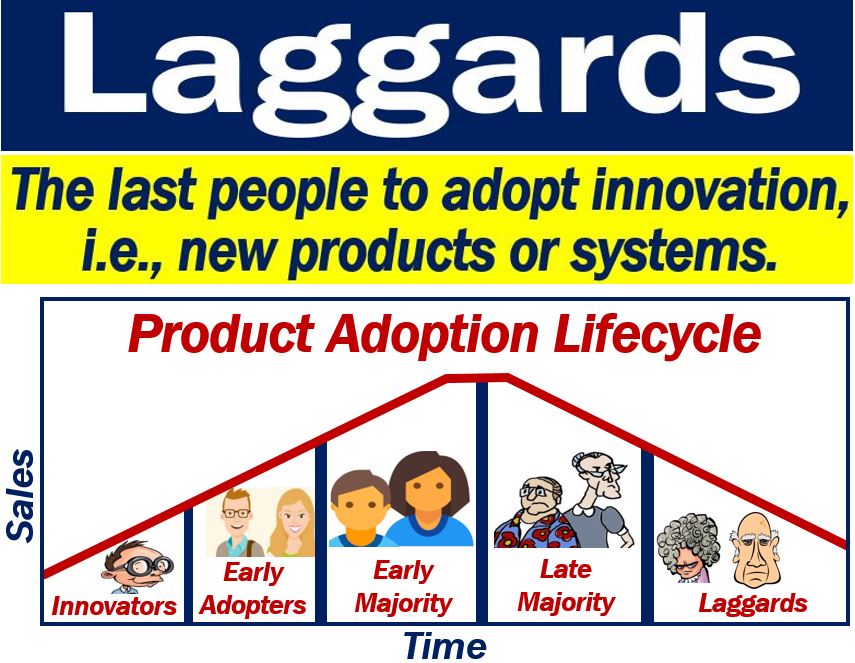Laggards – definition and meaning
Laggards are the last people in a population to adopt a new system or product. They belong to approximately sixteen percent of the population in the Diffusion of Innovations Theory.
Laggards typically have an aversion to change and things that trigger change. Laggards tend to focus on ‘traditions’ and are usually the oldest or poorest among adopters. They tend to use neighbors, friends, and family members as sources of information.
Diffusion of Innovations theory is a theory that attempts to explain how new ideas and technologies spread. It also seeks to explain at what rate and why new technologies and ideas spread.
The University of Oklahoma has the following definition of the term:
“Laggards are traditionalists and the last to adopt an innovation. Possessing almost no opinion leadership, laggards are localite to the point of being isolates compared to the other adopter categories.”
“They are fixated on the past, and all decisions must be made in terms of previous generations. Individual laggards mainly interact with other traditionalists.”
When a laggard adopts a new product or system, others may already consider it as obsolete.

Laggards and other groups
In Diffusion of Innovations theory, there are five categories of adopters: innovators, early adopters, early majority, late majority, and laggards.
-
Innovators
Innovators, who have the highest social status, are willing to take risks. They also have the closest contact to scientific sources and are social individuals.
They have financial liquidity and have more interaction with other innovators.
Innovators are not risk averse, i.e., they are not afraid to take risks. Hence, they are willing to adopt technologies that may eventually fail.
-
Early adopters
Among the categories, early adopters have the highest degree of opinion leadership. They also have financial liquidity, a relatively high social status, and a high level of education. They are more socially forward than the other categories below.
Compared to innovators, early adopters are more discreet in adoption choices.
According to Wikipedia, early adopters:
“Use judicious choice of adoption to help them maintain a central communication position.”
-
Early majority
Members of the early majority adopt an innovation considerably later than their early adopter counterparts.
Their social status is above average, and they also have close contact with early adopters. However, they rarely hold opinion leadership positions in a system.
-
Late majority
Late majority members usually adopt innovations later than the average person does. They approach innovations with a great deal of suspicion.
They tend to have below-average social status and also have little opinion leadership.
Late majority members have little financial liquidity and are typically skeptical about most innovations.
Laggards’ reluctance to adopt new technologies can significantly impede the overall diffusion process, as their resistance often influences the perceptions and decisions of the late majority group.
-
Laggards
As far as adopting new products or systems, laggards ‘lag‘ behind members of the other four groups.
A Boston University School of Public Health article titled ‘Diffusion of Innovation Theory,’ says the following regarding laggards:
“These people are bound by tradition and very conservative. They are very skeptical of change and are the hardest group to bring on board.”
“Strategies to appeal to this population include statistics, fear appeals, and pressure from people in the other adopter groups.”
Furthermore, the inherent skepticism and traditionalism of laggards often necessitate more personalized and community-based approaches to encourage their adoption of new innovations.
A very brief history of the word
The term ‘laggard’ comes from the verb ‘to lag’, which means ‘to fall behind.’
The root word “lag” comes from a Scandinavian source, similar to the Norwegian ‘lagga’ meaning “to go slowly.”
The word ‘Laggard’ emerged in the English language in England in 1590. Originally, laggard just meant the person who falls behind, i.e., the one who lags.
Over time, its meaning widened, and by the end of the nineteenth century, it also meant ‘somebody who is slow to adopt new ideas, technologies, or systems.’
Video – What are Laggards?
This video presentation, from our YouTube partner channel – Marketing Business Network, explains what a ‘Laggard’ is using simple and easy-to-understand language and examples.

